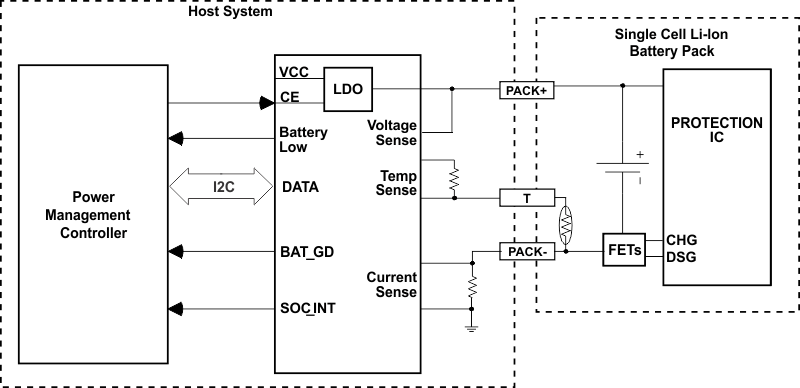SLUSB20C November 2012 – November 2021
PRODUCTION DATA
- 1 Features
- 2 Applications
- 3 Description
- 4 Revision History
- 5 Device Comparison Table
- 6 Pin Configuration and Functions
-
7 Specifications
- 7.1 Absolute Maximum Ratings
- 7.2 ESD Ratings
- 7.3 Recommended Operating Conditions
- 7.4 Thermal Information
- 7.5 Electrical Characteristics: Supply Current
- 7.6 Digital Input and Output DC Characteristics
- 7.7 Power-on Reset
- 7.8 2.5-V LDO Regulator
- 7.9 Internal Clock Oscillators
- 7.10 ADC (Temperature and Cell Measurement) Characteristics
- 7.11 Integrating ADC (Coulomb Counter) Characteristics
- 7.12 Data Flash Memory Characteristics
- 7.13 I2C-Compatible Interface Communication Timing Requirements
- 7.14 Typical Characteristics
- 8 Detailed Description
- 9 Application and Implementation
- 10Power Supply Recommendations
- 11Layout
- 12Device and Documentation Support
- 13Mechanical, Packaging, and Orderable Information
Package Options
Mechanical Data (Package|Pins)
- YZF|15
Thermal pad, mechanical data (Package|Pins)
Orderable Information
3 Description
The Texas Instruments BQ27520-G4 system-side Li-ion battery fuel gauge is a microcontroller peripheral that provides fuel gauging for single-cell Li-ion battery packs. The device requires little system microcontroller firmware development. The fuel gauge resides on the main board of the system and manages an embedded battery (non-removable) or a removable battery pack.
The fuel gauge uses the patented Impedance Track™ algorithm for fuel gauging, and provides information such as remaining battery capacity (mAh), state-of-charge (%), run-time to empty (minimum), battery voltage (mV), temperature (°C), and state of health (%).
Battery fuel gauging requires only
PACK+ (P+), PACK– (P–), and optional Thermistor (T) connections to a removable
battery pack or embedded battery circuit. The device uses a 15-ball NanoFree™ (DSBGA)
package in the nominal dimensions of
2610 × 1956 µm
with 0.5-mm lead pitch. It is ideal for space-constrained applications.
| PART NUMBER | PACKAGE(1) | BODY SIZE (NOM) |
|---|---|---|
| BQ27520-G4 | DSBGA (15) | 2.610 mm × 1.956 mm |
 Typical Application
Diagram
Typical Application
Diagram